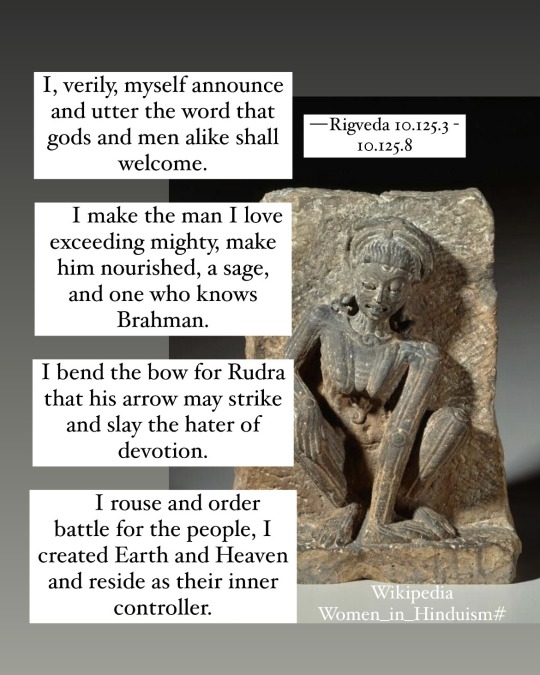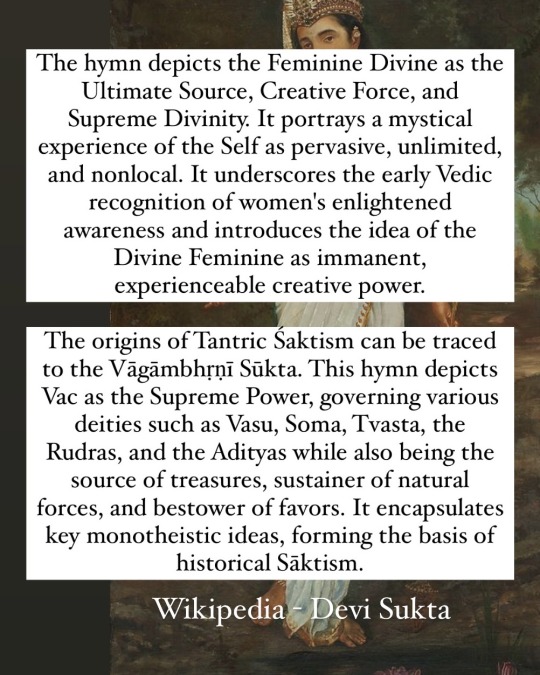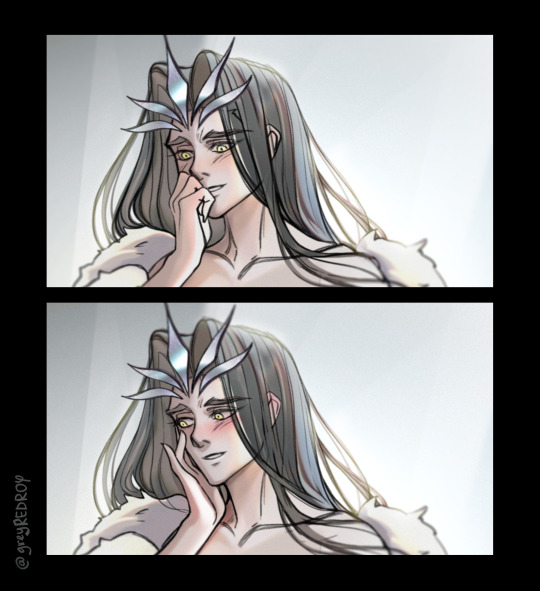#rigveda
Text
What is the purpose of chanting mantras in Hinduism?
To connect with the divine. Mantras are frequently visible as sacred sounds that may assist to attach the practitioner with the divine. When chanted with focus and attention, mantras can assist to quiet the mind and open the coronary heart, taking into consideration a deeper revel in of oneness with the divine.
To invoke a deity or energy. Mantras also can be used to invoke a selected deity or electricity. For instance, the mantra "Om Namah Shivaya" is frequently used to invoke the Hindu god Shiva. When chanted with the proper purpose, mantras can assist to deliver the practitioner into alignment with the characteristics and energies of the deity or power being invoked.
To create wonderful change. Mantras can also be used to create effective alternate in the practitioner's lifestyles. For example, the mantra "Om Shanti" is often used to convey peace and calmness to the mind. When chanted often, mantras can help to promote superb qualities such as love, compassion, and know-how.
To heal the frame and thoughts. Mantras have also been proven to have a advantageous effect on the frame and mind. For example, chanting mantras can assist to reduce stress, improve awareness, and improve the immune gadget. In some instances, mantras have even been used to help people heal from bodily and emotional ailments.
#vedic astrology#vedanta#vedas#rigveda#yajurveda#rg veda#veda#Vedic Jyotish Online#mantra#vedic mantra#spiritual enlightment#spirituality#spiritual development#spiritualawakening#enlightenment#enlightenedconsciousness#enlightenyourself#enlightenedbeings#mythology#hindu mythology#indian mythology#classical mythology#vedic mythology
59 notes
·
View notes
Text

Небо...мы впервые встретились с тобой глазами
Чаща расступилась, оставив ветвистый плен
Осязая свет Его взора, я покорно замер
И казалось, что земля сама коснулась колен
/quote by Лжедмитрий IV
#CLAMP#clamp fanart#聖伝#rigveda#rg veda#taishakuten#taishura#ashuraou#tsubasa reservoir chronicle#trc#greyredroy's art#my art
36 notes
·
View notes
Text

The stream of spiritual awareness, limitless, shining,
issuing forth from the ocean of cosmic intelligence,
comes onward with a tempestuous roar.
3 notes
·
View notes
Text

जय श्री राम🏹🌷🙏
-ऋग्वेद__📖.....✍️
4 notes
·
View notes
Text
@chartreuse-blood so, about your point on Narayan. I think his rise in prominence came from the fact that (I as a believing Hindu find true to my beliefs ) The Vedas were found during the Sagar Manthan, which means they were written beforehand when the council of heavenly deities still had their powers. It's only after they lose it when Vishnu plays his first big role in the mortal realm apart from Matsya which was secluded to Manu and people realise his prominence and start seeking him and Shiva (drank poison for the sake of world) directly?
Indra was cursed not to be worshipped anymore, but his hymns are there in Rigveda (I never completed it, I ought to :/) , so maybe it is that the Vedas were written when we were still more prominently nature worshippers in Satyug when deities roamed and later went on and had God realisation because the later hymns deal with consciousness and love of Supreme and paramatma better?
I mean, I'd be inclined to believe this because I KNOW the version of god(s) I have experienced is the big 4, but idk, thoughts?
Edit: I just checked with Quora, and the hymns supposedly few but still refer to Vishnu and Rudra as the Supreme and the Destroyer?
So they weren't minor gods, just less mentioned but still true to themselves. Nevertheless, I guess my above argument still stands?
23 notes
·
View notes
Text
Then even nothingness was not, nor existence,
There was no air then, nor the heavens beyond it
...Then there was neither death nor immortality
nor was there then the torch of night and day...
The One breathed windlessly and self-sustaining
There was that One then, and there was no other
At first there was only darkness wrapped in darkness.
Nasadiya Sukta, Rigveda Samhita, from The End Of Time, Yogesh Chandra
#the big bang theory#bigbang#universe#beginning#rigveda#rigvedasamhita#hindu vedas#veda#hinduscriptures#philosophy
3 notes
·
View notes
Text








The supreme goddess queen of creation, through power of sound energy & speech manifests her goddess-driven Will as the form of this world, right now-
She is the forces & laws of stability & balance, & so she will rise & go into battle with those who disregard the natural laws of balance, disrupting the harmony & welfare in Earth/ Heaven...
To be the inner controller, is to be the unseen, everlasting, permanent, eternal law that holds creation in place, in stability; around which everything else revolves, constantly self/auto regulating..
The principle applies on all scales, in Nature & Civilisation (economics, politics, justice etc.) — she says loud & clear "I pervade all",
", there is no situation, political or otherwise
outside of her Mother-Queen Supreme embrace...
"The law", "the force" — has been given many faces & archetypal representations over time, today we may see it as something like dharma, however the concept of dharma has also been misunderstood, misconstrued & conflated with other ideas...
#rigveda#presence#consciousness#awareness#Devi#Devi Sukta#vac#speech#war#spirituality#heart#spiritual#divinemother#nonduality#advaita#selfrealization
5 notes
·
View notes
Text
youtube
చెక్కడంలో దాగిఉన్న అంతర్గత వివరాలు! ప్రాచీన భారతీయుల అద్భుతమైన హస్తకళా!
Hey guys, ఈ రోజు నేను మీకు చాలా విచిత్రమైన, అంతర్గత వివరాలను చూపించబోతున్నాను. ఈ పురాతన శిల్పాన్ని చూడండి. ఇది చాలా విచిత్రంగా కనిపిస్తుంది కదా? ఇది నోరు తెరిచి ఉన్న, సింహం మాత్రమేనా? ఇక్కడ దాని మెడను చూడండి, దాని గొంతులో ఏదో ఇరుక్కుపోయినట్లు, ఏదో ఉబ్బెత్తుగా ఉన్నట్టుగా కనిపిస్తుంది కదా. ఇప్పుడు ఈ చెక్కడాన్ని చూడండి, ఇది ఇంతకు ముందు చూసిన శిల్పానికి పక్కనే ఉంది. ఈ శిల్పం మెడలో ఉబ్బినట్లు కనిపించడంలేదు చూడండి, కానీ గొంతు లోపల ఏదో ఉన్నట్టు మీరు చూడవచ్చు. ఈ రెండు చెక్కడాలు, నేల మట్టం నుండి 20 అడుగుల ఎత్తులో ఉన్నాయి, కాబట్టి నేను దీనికంటే betterగా photoను తీయలేకపోయాను, కానీ ఖచ్చితంగా, ఏదో ఒకటి, ఈ సింహం నోటి నుండి వస్తోంది, సరేనా?
మీలో కొందరు, ప్రవీణ్, మీరు ఎప్పుడూ లేని విషయాన్నీ, ఊహించుకుని చెప్తారు, ఇదంతా శిల్పులు చేసిన పొరపాట్లు మాత్రమే అయ్యుండొచ్చని మీరు అనుకోవచ్చు. దీన్ని చూడండి? ఏంటీ ఇది? అవునండి, ఒక వ్యక్తి, ఈ సింహం నోటి నుండి బయటకు వస్తున్నాడ���. ఇక్కడ చూడండి, అతని చేతులు, అతని తలను చూడండి, సింహం నోటి నుండి అతని మొండెం మాత్రమే బయటకు ఉంది. అతని రెండు కాళ్లు పూర్తిగా సింహం నోటి లోపల ఉన్నాయి. పురాతన నిర్మాణదారులు, మనకు ఏం చెప్పడానికి ప్రయత్నించారు? ఇప్పుడు, ఈ photosను చూడండి, ఒక మనిషి, నోటి నుండి చాలా నెమ్మదిగా బయటకు రావడాన్ని, step-by-step చూపించారు చూడండి, అతని మొత్తం శరీరం, దాదాపు పూర్తిగా బయటకు రావడాన్ని మీరు చూడవచ్చు.
ఇక్కడ, ఈ మనిషి, సింహం నోటి నుండి పూర్తిగా బయటకు వచ్చేసాడు. మనం చిన్న వయసులో, ఫ్లిప్ పుస్తకాలను ఎలా తయారు చేసామో గుర్తుందా? ప్రతి పేజీలో మనం, ఒక నిర్దిష్ట ఫ్రేమ్ని తయారు చేసి, ఆ పేజీలను తిప్పినప్పుడు, ఒక వ్యక్తి, తుమ్మినట్లుగా ఒక కథను చెప్పగలము కదా. దీన్నే మనం, ఈ గుడిలో చూస్తున్నాము, ఎలా ఒక మనిషిని, సింహం, బయటకు వదులుతుందని, మనం ఇక్కడ step by step చూస్తున్నాము. ఇప్పుడు మీలో కొందరు అనుకోవచ్చు, మనం రివర్స్ డైరెక్షన్లో చూస్తున్నామని అనుకోవచ్చు, అంటే, ఒకవేళ సింహం, ఈ మనిషిని కొంచెం కొంచెంగా, తింటోందని మీరు అనుకోవచ్చు, అయితే, దీన్ని మీరు రివర్స్లో చూసినప్పుడు, ఆ సింహం, ఆ మనిషిని తింటున్నట్లే కనిపిస్తుంది, కానీ నేను అలా అనుకోవడంలేదు. ఎందుకు? ఎందుకంటే, అతను చాలా ప్రశాంతంగా ఉన్నట్లు, ఈ శిల్పాలలో చూపించారు, ఆ వ్యక్తి భయాన్ని కానీ, ఆందోళన వంటి భావోద్వేగాలను అతని ముఖంలో చూపించలేదు, ప్రాచీన భారతీయ శిల్పులు, ఈ విధమైన భావోద్వేగాలను చెక్కడంలో మాస్టర్స్.
ఇతను, సాధారణంగా, ఈ సింహం నోటి నుండి వస్తున్నట్లు నాకు అనిపిస్తుంది. కానీ, దీని వెనుక ఉన్న కథ ఏంటీ? ఇతను ఆ సింహం నోటి లోపలికి ఎలా వెళ్లారు, తిరిగి బయటకు ఎలా వస్తున్నారు, ఇంతకీ ఈ వ్యక్తి ఎవరు? ఇప్పుడు, ఈ చెక్కడాన్ని చూడండి. దీని పక్కనే ఉన్న వ్యక్తి వైపు, అలానే అతని తలపై ఉన్నదేంటి అనే దాని గురించి ప్రస్తుతానికి మాట్లాడుకోవద్దు. ఇక్కడ కుండా లాగ ఉన్న ఒక container పైన మీ దృష్టి పెట్టండి. దీనిని కుంభం అని పిలుస్తారు, ఒక gel లాంటి liquid దీని చుట్టూ చిమ్ముతున్నట్టు చూపించారు, కొన్ని రకాల ద్రవాలు, ఈ కంటైనర్ నుండి బయటకు వస్తున్నాయి. ఎందుకు? ఎందుకు ఇలా వస్తున్నాయంటే, దాని లోపల ఉన్న ఈ వ్యక్తి కారణంగానే. ఎవరు ఇతను? అతను, ఈ కుంభం లోపల ఏమి చేస్తున్నాడు? ఇది ఒక సాధువు యొక్క అరుదైన చెక్కడం, ఇతని పేరు వశిష్ట. ఇప్పుడు, వశిష్ట అంటే ఎవరు? మన హిందూ మతం యొక్క, పురాతన గ్రంథమైన ఋగ్వేద రచయితలలో వశిష్ట ఒకరు. చాలా సాంప్రదాయిక అంచనాల ప్రకారం కూడా, ఋగ్వేదం 3000 సంవత్సరాల పురాతనమైనదిగా చెప్పబడింది. కానీ, వశిష్టను ఈ కంటైనర్ లోపల ఎందుకు చూపించారు? అతను, తన తల్లి గర్భంలో కాకుండా, గర్భం వెలుపల జన్మించిన ఒక టెస్ట్ ట్యూబ్ బేబీ. పురాతన భారతీయ గ్రంథాలలో, చాలా ఆకర్షణీయమైన విషయాలన్నీ ప్రస్తావించారు. వశిష్ట మరియు అగస్త్య, వీరిద్దరూ కవల సోదరులు, వీళ్ళు కృత్రిమ మార్గాల ద్వారా జన్మించారని వారు పేర్కొన్నారు.
Praveen Mohan Telugu
#ancienttemple#ancientsculpture#strangesculpture#ancientcarvings#ancientbuilders#ancientindia#advancedancienttechnology#ancientindiansculptors#artificialwomb#vasishta#hinduism#rigveda#ancientindiantexts#agastya#mysteriousbags#hindutemples#advanceddevices#ancientweapons#Youtube
2 notes
·
View notes
Quote
I am the Sovereign Queen; the treasury of all treasures; the chief of all objects of worship; whose all-pervading Self manifests all gods and goddesses; whose birthplace is in the midst of the causal waters; who in breathing forth gives birth to all created worlds, and yet extends beyond them, so vast am I in greatness.
The Rigveda, “The Devīsūktam”
42 notes
·
View notes
Photo

New Post has been published on https://www.knewtoday.net/the-vedas-sacred-scriptures-of-hinduism/
The Vedas: Sacred Scriptures of Hinduism

The Vedas are the ancient and revered scriptures of Hinduism, embodying the spiritual wisdom and religious practices of the ancient Indian civilization. Composed in Vedic Sanskrit, these texts have been passed down through generations for thousands of years and continue to hold immense significance in Hindu religious and philosophical traditions.
The word “Veda” originates from the Sanskrit root “vid,” which means knowledge or wisdom. Thus, the Vedas are often regarded as a divine revelation, representing the profound insights and eternal truths perceived by ancient seers and sages.
Believed to have been composed between 1500 and 500 BCE, though their oral tradition may extend even further back in time, the Vedas consist of four main collections known as Samhitas. These collections are the Rigveda, Yajurveda, Samaveda, and Atharvaveda. Each Samhita serves a distinct purpose, encompassing hymns, prayers, rituals, and philosophical discourses.
The Rigveda, the oldest and most significant of the four, contains hymns dedicated to various deities, celebrating cosmic forces and natural phenomena. It offers a glimpse into the religious and social life of the ancient Vedic society.
The Yajurveda focuses on the performance of rituals and sacrifices, providing detailed instructions and verses to guide priests during religious ceremonies. It emphasizes the importance of correct recitation and the proper execution of rituals for spiritual attainment.
The Samaveda centers around melodies and chants derived from the Rigveda. It is primarily concerned with the musical aspects of rituals, elucidating the power of sound and rhythm in invoking divine energies.
The Atharvaveda encompasses a diverse range of hymns, spells, and incantations. It addresses practical aspects of life, including healing, protection, and averting misfortunes. It also delves into philosophical and ethical teachings.
Additionally, the Vedas comprise supplementary texts known as Brahmanas, Aranyakas, and Upanishads. The Brahmanas provide ritualistic explanations, the Aranyakas serve as texts for hermits and seekers in forest retreats, while the Upanishads delve into profound metaphysical and spiritual concepts, exploring the nature of reality, self, and ultimate truth.
The Vedas hold a central position in Hinduism and are regarded as the foundational scriptures upon which the diverse branches and philosophies of Hindu thought have been built. They have influenced religious rituals, philosophical schools, and ethical principles throughout history, shaping the religious practices and beliefs followed by millions of Hindus worldwide.
Today, the Vedas continue to inspire seekers of wisdom, offering profound insights into the nature of existence and guiding individuals on their spiritual journeys. They stand as a testament to the ancient heritage and rich spiritual legacy of Hinduism, inviting contemplation, devotion, and the pursuit of eternal truth.
Rigveda
The Rigveda is the oldest and most important collection within the Vedas, consisting of hymns and prayers composed in Vedic Sanskrit. It is considered one of the oldest religious texts in the world, with origins dating back more than 3,500 years ago.
Structure and Contents:
The Rigveda is divided into ten books, known as Mandalas, and contains a total of 1,028 hymns, or Suktas, attributed to different sages and seers known as rishis. These hymns are addressed to various deities, such as Agni (the god of fire), Indra (the king of gods and the god of thunder and war), Varuna (the god of cosmic order and justice), and many others.
The hymns in the Rigveda are written in poetic and metaphorical language, often using intricate metaphors, symbolism, and allegories. They express deep reverence for nature, cosmic forces, and the divine, seeking blessings, protection, and guidance from the gods.
Themes and Significance:
The Rigveda covers a wide range of themes and topics, including creation myths, praises to the gods, nature worship, cosmology, ethical values, social order, and the importance of rituals. It reflects the religious and social practices of Vedic society, providing insights into their beliefs, rituals, and worldview.
The hymns of the Rigveda offer a glimpse into the religious and spiritual experiences of the ancient Vedic seers. They express a sense of wonder and awe towards the natural world, seeking to understand the mysteries of existence and the relationship between humanity and the divine.
Philosophical Teachings:
While the Rigveda is primarily a collection of hymns, it also contains philosophical insights and contemplative reflections. Some hymns explore the nature of reality, the concept of Brahman (the ultimate reality), and the pursuit of knowledge and truth. They discuss philosophical questions regarding the origins of the universe, the nature of existence, and the purpose of human life.
Influence:
The Rigveda has had a profound influence on Hindu religious, social, and cultural practices. Its hymns and rituals form the foundation of the Vedic sacrificial ceremonies and have shaped the development of Hinduism over the centuries. The concepts and ideas found in the Rigveda have influenced subsequent Hindu scriptures, philosophical schools, and religious practices.
The Rigveda is not only a religious text but also a significant literary and historical document. It provides valuable insights into the early Vedic civilization, its language, social structure, and religious practices. Scholars and researchers continue to study and interpret the Rigveda to deepen their understanding of ancient Indian culture and religious traditions.
Overall, the Rigveda stands as a testament to the ancient wisdom, poetic brilliance, and spiritual quest of the Vedic seers, offering a profound glimpse into the religious and philosophical thought of the time and contributing to the rich tapestry of Hindu spirituality.
Yajurveda
The Yajurveda is one of the four main collections of the Vedas, the ancient scriptures of Hinduism. It is primarily focused on the performance of rituals and sacrifices, providing instructions, formulas, and verses for priests to follow during religious ceremonies. The Yajurveda is written in Vedic Sanskrit and is considered a crucial guidebook for priests or “yajurvedis” to carry out sacrificial rites.
Structure and Contents:
The Yajurveda is divided into two main branches or versions: the Krishna Yajurveda (Black Yajurveda) and the Shukla Yajurveda (White Yajurveda). The Krishna Yajurveda contains prose and verse portions mixed together, while the Shukla Yajurveda consists primarily of prose sections. Both versions contain rituals and formulas for the performance of sacrifices, but they differ in arrangement and presentation.
The Yajurveda contains hymns and mantras, referred to as “Yajus,” which are recited during various stages of sacrificial rituals. These mantras are precise and formulaic, serving as instructions for the priests regarding the actions to be taken, the offerings to be made, and the recitation of prayers and invocations.
Themes and Significance:
The Yajurveda emphasizes the importance of correct pronunciation and the precise execution of rituals. It provides detailed descriptions of various rituals, including the preparation of altars, the kindling of sacred fires, the offering of oblations, and the chanting of specific mantras. The rituals outlined in the Yajurveda were performed as acts of devotion, seeking blessings, and establishing a harmonious relationship between humans and deities.
The Yajurveda also contains philosophical and moral teachings. It emphasizes the interconnectedness of all beings and the importance of living in harmony with the natural and cosmic order. It highlights the concept of dharma (righteousness) and encourages ethical conduct, social responsibility, and spiritual growth.
Influence:
The Yajurveda has played a significant role in shaping Hindu religious practices and rituals. It served as a practical guide for priests in performing sacrifices and ceremonies, ensuring that rituals were carried out with precision and adherence to tradition.
While the Yajurveda is primarily concerned with rituals, it also contains philosophical insights and contemplations on the nature of the universe, the relationship between the divine and the mortal, and the pursuit of spiritual enlightenment. These philosophical aspects have contributed to the development of Hindu philosophy and provided a foundation for later texts, such as the Upanishads.
The teachings of the Yajurveda continue to be influential in contemporary Hindu rituals, especially in the performance of religious ceremonies, including marriages, fire sacrifices, and other religious rites. Its mantras and rituals are still recited and followed by priests and practitioners in traditional Vedic ceremonies.
In summary, the Yajurveda is a crucial Vedic text that provides detailed instructions and formulas for performing rituals and sacrifices. It holds significance in preserving ancient Vedic traditions, promoting ethical values, and guiding practitioners in their spiritual journey and devotion to the divine.
Samaveda
The Samaveda is one of the four main collections of the Vedas, the ancient scriptures of Hinduism. It is primarily focused on the musical aspects of rituals and sacrifices, containing a collection of melodies and chants derived from the Rigveda. The Samaveda is written in Vedic Sanskrit and is considered the earliest known musical text in the world.
Structure and Contents:
The Samaveda consists of a compilation of melodies and chants, known as Samans, which were sung during Vedic rituals. These chants are derived from the hymns of the Rigveda but are set to melodic patterns and rhythms. The melodies were sung by a group of priests called the Samavedins, who were responsible for the musical aspects of the rituals.
The Samaveda is organized into two main sections: the Purvarchika (First Archika) and the Uttararchika (Later Archika). The Purvarchika contains melodies from the Rigveda, while the Uttararchika comprises additional melodies specific to the Samaveda. Each section is further divided into chapters and subsections.
Themes and Significance:
The Samaveda places great importance on the musical recitation of the Vedic hymns. It focuses on the precise chanting of the mantras, the correct pronunciation of syllables, and the modulation of the voice to create a melodic and rhythmic flow. The melodies and chants of the Samaveda were believed to have a profound impact on the mind, invoking specific energies and facilitating the connection between humans and the divine.
The Samaveda also highlights the power of sound and its ability to evoke spiritual experiences. It emphasizes the concept of Nada Brahman, the divine essence manifesting as sound vibrations. The Samaveda recognizes that the musical recitation of the Vedic hymns can lead to a transcendental experience, helping individuals attune themselves to cosmic harmony and experience a sense of unity with the divine.
Influence:
The Samaveda has had a significant influence on the development of Indian classical music and its spiritual dimension. The musical patterns and techniques found in the Samaveda served as the foundation for the melodic structures and ragas in Indian classical music. The concept of using sound as a means of spiritual elevation and self-realization is a core principle in Indian music and can be traced back to the Samaveda.
The Samaveda’s emphasis on the power of sound and its connection to the divine has also influenced the practice of chanting and mantra recitation in Hinduism. Chanting sacred verses and mantras is considered a potent spiritual practice, believed to have transformative effects on the mind, body, and spirit.
While the Samaveda may not be as widely studied or practiced as the other Vedas, its musical and spiritual legacy continues to resonate in Hindu traditions. Its melodies and chants are occasionally performed in religious ceremonies and festivals, preserving the ancient musical heritage and the profound spiritual significance of sound in the Vedic tradition.
In summary, the Samaveda is a Vedic text dedicated to the musical recitation of Vedic hymns. It highlights the power of sound, melodies, and chants to create a sacred atmosphere and facilitate a connection with the divine. Its influence can be seen in the development of Indian classical music and the continued practice of chanting in Hindu rituals and spiritual disciplines.
Atharvaveda
The Atharvaveda is one of the four main collections of the Vedas, the ancient scriptures of Hinduism. It is distinct from the other Vedas in terms of its content and style. While the other three Vedas (Rigveda, Yajurveda, and Samaveda) primarily focus on hymns, rituals, and chants, the Atharvaveda includes a compilation of hymns, spells, and incantations for practical purposes.
Structure and Contents: The Atharvaveda is divided into twenty books, known as Kandas, and contains a total of 730 hymns or Suktas. These hymns are attributed to various rishis (seers) and are written in Vedic Sanskrit. The Atharvaveda is believed to be a later addition to the Vedic texts, likely composed around 1000 BCE.
Unlike the other Vedas, the Atharvaveda incorporates a broader range of topics and addresses practical aspects of life. It includes hymns and spells for healing, protection, exorcism, fertility, prosperity, and averting misfortunes. The hymns also touch upon social and ethical issues, as well as philosophical and metaphysical themes.
Themes and Significance: The Atharvaveda encompasses a diverse array of themes and rituals. Some of the prominent themes found within the Atharvaveda include:
Healing and Medicine: The Atharvaveda contains numerous hymns and spells for healing ailments, both physical and mental. It includes prayers and incantations for curing diseases, invoking the healing powers of various deities and natural elements.
Protection and Averting Evil: The Atharvaveda includes spells and rituals for protection against evil forces, black magic, and negative energies. These hymns and incantations aim to shield individuals, homes, and communities from harm and ill fortune.
Social and Domestic Life: The Atharvaveda addresses various aspects of domestic and social life. It provides guidance on marital relationships, childbirth, family harmony, agriculture, and general well-being.
Ethical and Philosophical Teachings: Alongside the practical spells and rituals, the Atharvaveda includes hymns that explore ethical values, righteous conduct, and philosophical reflections. It delves into the nature of reality, the meaning of life, and the pursuit of spiritual knowledge.
Influence:
Atharvaveda’s practical approach and focus on everyday concerns have made it relevant in diverse aspects of Hindu culture and society. Its spells and rituals are still practiced by certain communities and individuals seeking remedies, healing, and protection. Some of the practices and beliefs associated with traditional folk medicine and folk rituals in India can be traced back to the Atharvaveda.
The philosophical and ethical teachings found within the Atharvaveda have also contributed to the development of Hindu thought and spirituality. The ethical principles and reflections on the nature of existence continue to inspire philosophical inquiry and spiritual contemplation.
While the Atharvaveda is sometimes considered distinct from the other Vedas due to its content and style, it remains an essential part of the Vedic tradition. Its inclusion in the Vedas testifies to the rich and diverse tapestry of ancient Indian wisdom and showcases the practical and spiritual dimensions of Vedic knowledge.
In summary, the Atharvaveda stands apart from the other Vedas with its hymns, spells, and incantations for practical purposes. It addresses healing, protection, social life, and philosophical reflections. The Atharvaveda’s influence can be seen in healing practices, rituals, and philosophical contemplations that continue to resonate in Hindu culture and spirituality.
#AncientIndianCivilization#Atharvaveda#Hinduism#HinduTraditions#Philosophy#ReligiousTexts#Rigveda#Rituals#SacredScriptures#Samaveda#SpiritualWisdom#Vedas#VedicSanskrit#Yajurveda
2 notes
·
View notes
Text
Lagnesh in Various Houses in Astrology - Part 1
Lagnesh in the houses of the horoscope
Lord of the 1st house in the houses of the horoscope
The first house's ruler is known as Lagnesha since the first house is sometimes called Lagna (Lagna lord). The position of Lagnesh will reveal the person's natural area of interest and the location where they are investing the most energy. The native's primary area of interest, Paka-lagna, indicates the subjects on which he centres his life and through which he comes to understand himself.
The effects of Lagnesh's (the lord of Lagna or first house's) placement in the horoscope's houses
Lord Of the 1st house in the 1st house
Lagnesh is at home, where he feels at ease. This indicates that a person closely monitors his or her body and health and places a special wager on it. The indicators of the first house are strong (health, self-confidence).
He is his own master, self-centered, loves fame and a good name, erratic, fearless, and triumphs over challenges. A position like that ensures good health, admirable character traits, and a long, prosperous life. Sons are typically born first, planet in swakshetra (one's own home). A happy upbringing, a successful start to life, being born into a wealthy or noble family, strength, health, respect, a strong sense of duty, happiness, the capacity for leadership, and longevity.
Strong, attractive, and independent in spirit; most likely married twice. These individuals could be egotistical or overly self-conscious. Physical strength and widespread appeal are provided by this combination. The local will get good health and physical courage if the lagna's ruler immediately occupies the lagna. He will have two marriages and have intercourse with other women. He will be thoughtful, intelligent, and inconsistent in ideas. (From Brihat Parasara Hora Shastra, verse 26.1)
The native has a majestic appearance, a healthy body, and strong strength to resist illnesses if the lagna's king is in the lagna itself. Yet, these characteristics of the native will surprise you if there are negative influences.
Lord of the 1st house in the 2nd house:
Crossing the signs of the first and second houses indicates a desire to hoard (knowledge or money), clear vision, express oneself verbally, and deep ties to family.
educated, learned, a missionary, good, fair, wealthy, distinguished by lofty character traits and incredible foresight, concerned about the welfare of his family, but with somewhat petty-bourgeois interests. adversaries causing suffering. Wealth, good education, interest in and potential career in education, a pleasant family life, integrity, good speech, public speaking, and an interest in financial matters are all present in the first kid, a boy. The individual will be adept at producing money and have a strong attachment to family life. Expectable traits include a lack of children, charity, and restlessness.A solid education and the capacity for prediction are evident. When the lagna's ruler is in the second bhava, the native will want wealth, be knowledgeable, joyful, kind, spiritual or religious, noble, have a lot of wives, and have other admirable traits. (From Brihat Parasara Hora Shastra, verse 26.2)Comments: If the Lagna ruler is in the second bhava [house], the native is likely to be thrifty, practical, and economical. He possesses incredible foresight or forethought, and his commercial endeavours frequently result in financial success. The native is endowed with great powers of observation and investigation thanks to the fact that the lagna's ruler is in the vision bhava in this combination. His conclusions have the potential to have significant effects, and his strategies work.
Because the second bhava is the bhava of the right eye, his eyes have the capacity to see and comprehend the laws.
Lord of the 1st house in the 3rd house:
A person who is determined and entrepreneurial emerges when the indicators of the first and third houses are combined (particularly if the lagnesh is a negative planet) (Saturn, Mars). The native can discover who they are through manual labour, art, interaction, and literary pursuits.
brave, powerful, wise, kind, considerate, wealthy, well-respected, surrounded by nice friends and family, charitable, worldly, self-centered.
Gains from brothers and sisters, bravery, initiative, and self-effort are crowned with success, a strong will, perseverance, and a nature filled with strong desires. a passion for and potential profession in music, dance, or theatre. .. a person of courage, independence of thought, and generosity, with dexterous hands and a commanding voice. They will have a large number of marriage partners and hold a respected position in society. .. The native will be brave like a lion, have a variety of wealth, be noble, have two wives, and be intelligent and content if the lagna's ruler is in the third bhava. (From Brihat Parashara Hora Shastra, verse 26.3)
Comments:The third bhava, or "house," represents one's physical prowess, bravery, and strength. The native would be exceedingly entrepreneurial and have the courage to deal with any scenario if the lagna ruler is in the third bhava. The third bhava, where the lagna and its lord symbolise the body, will show the body's physical prowess to its fullest extent. The native will require more food and have a more balanced diet if the lagna's ruler is in the third bhava. The native will begin to make less money around the age of 40 or 45 if the Lagna is Mithuna [Gemini] and the ruler of the Lagna is in the third bhava.
His vigour and strength are dwindling. When Shani [Saturn] is in the Rashi [sign] of debilitation in the Kumbha [Aquarius] Lagna, which occurs when the lord of the Lagna is in the third bhava, opposite outcomes will be observed.
1st lord in 4th house
The owner of the first in the fourth is a native who values a comfortable living, a good environment, and a love of learning. Perhaps connected to the themes of real estate, construction, renovation, transportation, psychology, and education.
Gorgeous, descended from a noble family, sensual, sensuous, ambitious, joyful, does good deeds, owns land and family property, prospers via his own efforts, and works in accordance with his heart, not his mind. He also conducts good deeds. The man's parents are contented people. Inheritance property, a college degree, longevity, good health, a spiritual nature, or an interest in moksha (ultimate liberation) will all be given to the person, along with their own home, land, cars, yachts, and other real estate, good status or fame, respect, happiness from their mother, and inheritance property. a person of good birth, a landowner, friendly, and well-liked. These folks are well-educated, have a lot of cars, and care deeply about their homes and properties.
If the ruler of the lagna is in the 4th bhava, then the native will be blessed with paternal and maternal happiness, a large number of brothers and will be voluptuous, virtuous and charming. (Brihat Parasara Hora Shastra 26.4)
Comments: When the ruler of the lagna occupies the house in the 4th bhava, the native will not only be voluptuous, he will also become very sensitive mentally. The 4th bhava is associated with the mind and psychological results. Lagna itself is the body. The psychology of sexual relations is very close to the body. Therefore, a native can be voluptuous or lustful. Such a person takes special care of his body. He is always preoccupied with decorating his body and improving his appearance.
When the lagna is Mesha (Aries) and Makara (Capricorn), the beneficial effects of this sloka will not be observed. Because the lord of the lagna will be in the rashi [sign] of debilitation if he is situated in the fourth bhava, the results in these lagnas will be the opposite.
#astrology#vastu#vedic astrology#vastu shastra expert#vaastu#aries astrology#astro notes#predictive astrology#astro#moksha#ascendant#numerology#vaastu shastra#Nakshatra#vedas#Vedic Jyotish Online#vedic astro observations#astrology numerology vedicastrology#vedanta#rigveda#yajurveda#rg veda#rig veda#vedic india#astrology numerology vedicastrology#vedic chart#vedicknowledge#Jyotish#Kundali#online kundali
81 notes
·
View notes
Text

Yaaaay finally some new content with celes!taishura!
and some sequences based on it


and just a close up of this Ashure because i love him here so MUCH!

#my art#greyredroy#clamp fanart#trc#ashuraou#tsubasa reservoir chronicle#tsubasa chronicle#clamp#taishura#taishakuten#rigveda#rg veda#アシュラ王
26 notes
·
View notes
Text
Gayatri Mantra
ओम भूर्भव: स्व: तत्सवितुर्वरेण्यं । भर्गो देवस्य धीमहि धियो यो न: प्रचोदयात्।।
Om bhur bhuvaha svaha Tat savitur varenyam Bhargo devasya dhimahi Dhiyo yo nah prachodayat
We meditate on the glory of the Creator; Who has created the Universe;
Who is worthy of Worship; Who is the embodiment of Knowledge and Light; Who is the remover of all Sin and Ignorance; May our Intellected be Enlightened.
5 notes
·
View notes
Text
Celebrating the Year of ‘Millets’ through its Knowledge from Vedas to Present
Dr. Raghava S. Boddupalli and Dr. Aparna Dhir Khandelwal
Pandemic era has turned everyone to think about or to be more conscious towards one’s own health. Presently, around the globe people are running for organic food items that enable them to lose weight, controls cholesterol & blood sugar levels, fight against heart diseases, etc. With the present year, India has taken up the presidency of…

View On WordPress
#Agni#Atharvaveda#Ayurveda#Culture#G20 Summit#Homa#Kalidas#Millets#Nakshtra#Rigveda#Rudra#Sacrifice#Sayanacharya#Sushruta#Upanishad#Vedas#Vedic#Vishnu#Vyasa#Yajna#Yajurveda
2 notes
·
View notes

